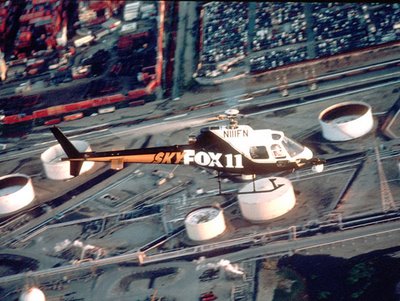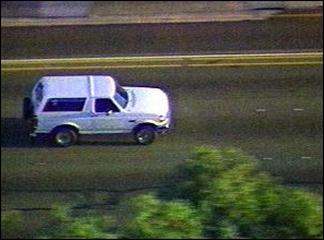But occasionally there's some action – and the true magic of the system begins.

LA's unacknowledged cinema – its highway network – was the focus of a recent article, by Tad Friend, in The New Yorker. During the OJ chase of 1994, Friend writes, "from the cameras above, the customary vantage for tracking the city's televised pursuits, you could see that this most sprawling and motorized of our great metropolitan areas is a huge web that is easily apprehended from the air – some forty police and TV helicopters keep busy doing just that – and that it is not the roadways but their surveillance that never ends." (My emphasis). Or, as Mike Davis writes in City of Quartz: "thousands of residential rooftops have been painted with identifying street numbers, transforming the aerial view of the city into a huge police grid."
In other words, whether operated by FOX, CNN, or the LAPD, traffic helicopters give Los Angeles an urban coherence that few drivers and pedestrians may ever understand – till they see it on TV.

Within those surveilled streets – what Friend calls LA's "public stage, its Colosseum" – there have been as many as 5,596 car chases in one year (2004). Yet this should surprise no one: LA's "ten million occupants are all ceaselessly trying to go very different places by very elaborate routes that gum up everyone else's very elaborate routes. So the two people who stole a big rig filled with mixed melons last July and then led police on a four-hour meander around the 5, the 605, the 215, and the 15 freeways were, by local standards, behaving logically. And as for the trucker a few years back who fled deputies after a traffic collision, drove his eighteen-wheeler through the fence surrounding Long Beach Airport, overturned it on the main runway, set the cab on fire, and then ran away without any clothes on – well, fair enough, really."
As a transportation technique, or genre of driving, the chase is an entirely sensible use of the LA highway system. In some ways that's what it's built for. "This is as much city planning," Friend writes, "as it is producing – a vision of a metropolis knit together by speed and spectacle."

[Image: David Maisel, from the Oblivion series].
What's even more interesting is that the LAPD have begun to change their tactics of pursuit, including radio communication strategies, so as not to bring undue televisual attention upon the chases, the chasers, or the chased themselves – who often see these high-speed extravaganzas as a kind of initial public offering, or debut role, a break-out performance watched by captivated millions.
There is even a burgeoning visual style or cinematography associated with this tele-vehicular art form: "The frame of the pursuit – a cropped shot of an anonymous vehicle moving at ominous speed through a featureless landscape – has not been updated since the genre began."

[Image: OJ Simpson's infamous white Bronco; in a parallel universe, ruled by Philip K. Dick, this image would be used as the next American flag].
Meanwhile, whole subsidiary industries have arisen on the fringes of the car chase scene. Wired, for instance, writes about James Tatoian, who is "developing a system that uses microwave energy to interfere with microchips inside cars. Once the chip is overloaded with excessive current, the car ceases to function, and will gradually decelerate on its own."
Then, in the slightly Orwellian field of "pursuit management" – a growth industry, I'm sure – StarChase LLC has developed a GPS dart system that consists of "a tracking projectile with a miniaturized GPS receiver, radio transmitter, power supply and a launcher which can be hand-held or mounted on a police car." Shoot this thing at a fleeing car – and you can track it via satellite. (More here).
Yet another way to manage pursuits? As Tad Friend writes: "Within fifteen years or so, when all new cars will be equipped with OnStar-type security systems, the LAPD hopes to be able to override disobedient drivers using the quintessential weapon of the video age: a remote control."
There's even a "Pursuit Intervention Technique, or PIT," which basically sets a fleeing car spinning – because a police car has just rammed into it.

[Image: A different kind of intervention technique].
In any case, what interests me here is not police pursuit technology in and of itself, but the fact that it has slowly become a regular feature of American urban life. Even more, the car chase, though illegal, irresponsible, and dangerous, is also one of the most logical responses to the American landscape: if you build "nine hundred miles of sinuous highway and twenty-one thousand miles of tangled surface streets" (Tad Friend) in one city alone, you're going to find at least a few people who want to put it to use.
Add that to uncountable thousands of cameras installed there on lightposts, or carried by helicopters throughout the sky – the endless cinema of the everyday, an anthropologist's dream – and anyone driving in LA right now is literally only moments away from celebrity. Go a little further, a little faster – and fifteen minutes after you read this post, I might be watching you on TV.
Be sure to wave.
[Note: Perhaps this is needless to say, but if you go whizzing off into la la land and drive your car through a house – it ain't the fault of BLDGBLOG. Buckle up. And you can find more of this here].
No comments:
Post a Comment